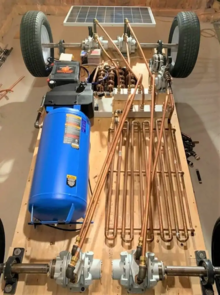

A compressed-air vehicle (CAV) is a transport mechanism fueled by tanks of pressurized atmospheric gas and propelled by the release and expansion of the gas within a pneumatic motor.
CAV's have found application in torpedoes, locomotives used in situations where standard locomotives are a hazard, and early prototype submarines.
Compressed-air vehicles operate according to a thermodynamic process where air cools down when expanding and heats up when being compressed and those are thermal energy losses that drain the capacity factor, however with the recent developments in isothermal compressed air energy storage ICAES plants, compressed air storage has reached 4 times the capacity factor of lithium-ion batteries with 2.7 MJ/kg or 3.6 MJ/m3[3] and in 2020 there has been developments in ICAV car or isothermal compressed-air vehicle published by Dr. Reza Alizade Evrin from Ontario Tech University[1][2] with a first prototype that uses low-pressure air tanks and exhaust air recovery to power a paraffin heat exchanger system with a global energy efficiency of 74% (reaching 73–90% efficiency of lithium-ion electric cars) with a driving range of 140 km (87 mi). This efficiency and range can be increased by using storage tank as vehicle chassis structure, high-pressure tanks, new rotary engines, and a more efficient heat exchanger.
This breakthrough, together with the availability of recycled and bio-based thermoplastics for tanks, pneumatic components and renewable energy means this technology can be the basis of a free green transportation revolution with energy and circular industry decentralization with open source numerical control machines fabrication including additive manufacturing, while multistage air compressors and coolers or hydraulic pumps can be attached directly to VAWT wind turbines, stirling engine with a parabolic or Fresnel lens solar concentrator or river, tidal, wave hydropower turbine with no electric energy or electric grid needed nor energy conversion inefficiencies or additional energy storage, also instead of onboard heat recovery system there can be used a refillable molten salt (from Fresnel lens or parabolic Concentrated solar power) reservoir in a heat exchanger system.
Compressed-air propulsion may also be incorporated in hybrid systems, such as with battery electric propulsion. This kind of system is called a hybrid-pneumatic electric propulsion. Additionally, regenerative braking can also be used in conjunction with this system.
- ^ a b "Compressed air cars for urban transportation". advancedsciencenews. 7 September 2020. Retrieved 2020-09-07.
- ^ a b Evrin, Reza Alizade; Dincer, Ibrahim (2020). "Experimental investigation of a compressed air vehicle prototype with phase change materials for heat recovery". Energy Storage. 2 (5). onlinelibrary.wiley. doi:10.1002/est2.159. S2CID 219020514.
- ^ Odukomaiya, Adewale; Abu-Heiba, Ahmad; Gluesenkamp, Kyle R.; Abdelaziz, Omar; Jackson, Roderick K.; Daniel, Claus; Graham, Samuel; Momen, Ayyoub M. (2016). "Thermal analysis of near-isothermal compressed gas energy storage system". Applied Energy. 179. semantic scholar: 948–960. Bibcode:2016ApEn..179..948O. doi:10.1016/J.APENERGY.2016.07.059. OSTI 1324083. S2CID 113436358.